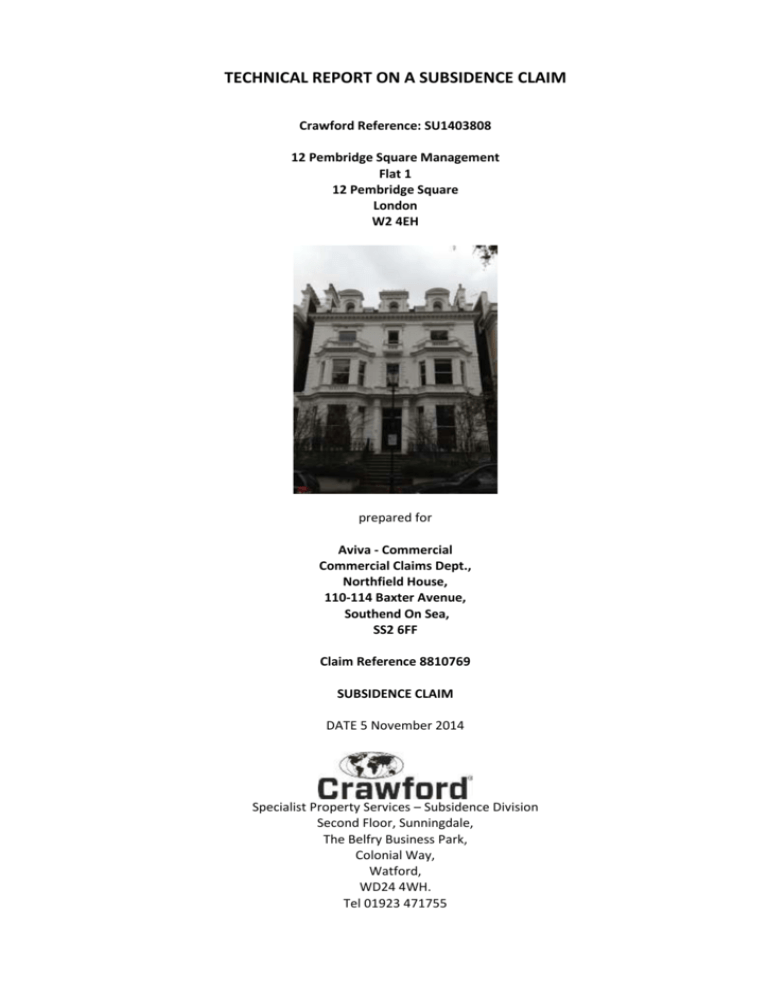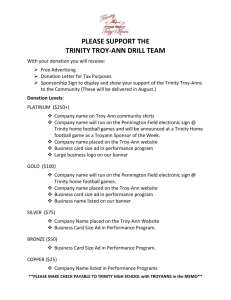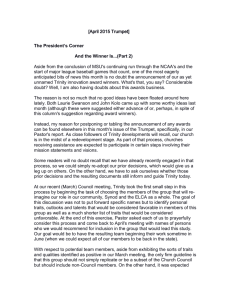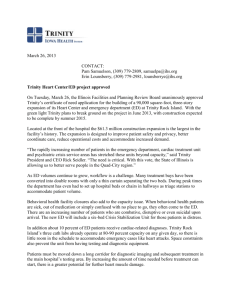
TECHNICAL REPORT ON A SUBSIDENCE CLAIM
Crawford Reference: SU1403808
12 Pembridge Square Management
Flat 1
12 Pembridge Square
London
W2 4EH
prepared for
Aviva - Commercial
Commercial Claims Dept.,
Northfield House,
110-114 Baxter Avenue,
Southend On Sea,
SS2 6FF
Claim Reference 8810769
SUBSIDENCE CLAIM
DATE 5 November 2014
Specialist Property Services – Subsidence Division
Second Floor, Sunningdale,
The Belfry Business Park,
Colonial Way,
Watford,
WD24 4WH.
Tel 01923 471755
TECHNICAL REPORT
Site Plan
This plan is Not to Scale
This plan is diagrammatic only and has been prepared to illustrate the general position of the property and its relationship to
nearby trees etc. The boundaries are not accurate, and do not infer or confer any rights of ownership or right of way. Position
of utilities is only indicative and contractors must satisfy themselves regarding actual location before commencing works.
Deciduous
H10
D5
© Bluesky International & © Infoterra 2006.
Map Reproduced with the Permission of Ordnance Survey License Number ########
Key:
Tree: Deciduous
Tree: Conifer
Shrub
Hedge
Area of Damage
Bore Hole
Trial Hole
Trial & Bore Hole
Level Monitoring
Rain Water Manhole
Rain Water Gulley
Rain Water Pipe
Waste Water Manhole
Waste Water Gulley
Toilet Pipe
Rain Water Drain
Waste Water Drain
Electricity Cable
Water Supply Pipe
Gas Supply Pipe
Incoming Gas Pipe
Incoming Water
Incoming Electrics
Chartered Loss Adjusters
Second Floor, Sunningdale, The Belfry Business Park, Colonial Way, Watford, WD24 4WH. Tel 01923 471755 www.crawfordandcompany.com
Registered Office Crawford & Company Adjusters (UK) Ltd, Trinity Court, 42 Trinity Square, London, EC3N 4TH Registered in England No 2908444
TECHNICAL REPORT
INTRODUCTION
We have been asked by Aviva - Commercial to comment on movement that has taken place to the
above property. We are required to briefly describe the damage, establish a likely cause and list any
remedial measures that may be needed.
Our report should not be used in the same way as a pre-purchase survey. It has been prepared
specifically in connection with the present insurance claim and should not be relied on as a
statement of structural adequacy. It does not deal with the general condition of the building,
decorations, timber rot or infestation etc.
The report is made on behalf of Crawford & Company and by receiving the report and acting on it,
the client - or any third party relying on it - accepts that no individual is personally liable in contract,
tort or breach of Statutory duty. Where works address repairs that are not covered by the insurance
policy we recommend that you seek professional advice on the repair methodology and whether
the works will involve the Construction (Design & Management) Regulations 2007. Compliance with
these Regulations is compulsory; failure to do so may result in prosecution. We have not taken
account of the regulations and you must take appropriate advice.
Investigations have been carried out in accordance with the requirements of The Institution of
Structural Engineers1.
We have not commented on any part of the building that is covered or inaccessible.
TECHNICAL CIRCUMSTANCES
The insured identified cracking to the rear of the property in May. A drainage survey was carried out
which identified a number of defects to the drainage. He had these repaired however following
worsening of cracking he consulted a structural engineer to comment on the damage and a claim
was subsequently notified to insurers.
PROPERTY
The property comprises a four storey with basement multi-occupied detached residence of
traditional construction with rendered walls surmounted by a ridged slated roof.
HISTORY & TIMESCALE
Site investigations are being organised and crack monitoring established.
Date of Construction ................................................... Circa 1850
Purchased .................................................................... To be confirmed.
Policy Inception Date .................................................. 01/02/2014
Damage First Noticed .................................................. May 2014
Claim Notified to Insurer……………………… .................... 20/10/2014
Date of our Inspection................................................. 03/11/2014
Issue of Report ............................................................ 10/11/2014
Anticipated Completion of Claim ................................ June 2015
TOPOGRAPHY
The property occupies a reasonably level site with no unusual or adverse topographic features.
1
Institution of Structural Engineers (1994) “Subsidence of Low Rise Buildings”
Chartered Loss Adjusters
Second Floor, Sunningdale, The Belfry Business Park, Colonial Way, Watford, WD24 4WH. Tel 01923 471755 www.crawfordandcompany.com
Registered Office Crawford & Company Adjusters (UK) Ltd, Trinity Court, 42 Trinity Square, London, EC3N 4TH Registered in England No 2908444
TECHNICAL REPORT
GEOLOGY
Reference to the 1:625,000 scale British Geological Survey Map (solid edition) OS Tile number
TQNW suggests the underlying geology to be London Clay.
London Clays are marine deposits characterised by their silty, sandy composition. They are typically
stiff, dark or bluish grey, weathered dark to mid-brown superficially with fine particle size (less than
0.002mm). Tomlinson2 describes it as a ‘fat’ clay with high loadbearing characteristics due to preconsolidation pressures in its geological history.
The upper horizon is often encountered at shallow depth, sometimes just below ground level. They
have high shrink/swell potentials3,4 and can be troublesome in the presence of vegetation.
The superficial deposits are thought to be Sand and Gravel.
Sand is a detrital sedimentary rock (arenaceous - sandy) with a grain size in the range of 0.06 - 2mm
in diameter. Individual [particles are mainly mineral fragments, and quart grains predominate5.
Gravels on the other hand have particles in the range of 2 - 60mm in diameter. Above this, in size,
are cobbles (60 - 200mm diameter) and boulders (200mm in dia. and above).
Generally a good bearing medium, but finer grained soils can suffer erosion in flowing water, and
liquify when under the water table (quicksand). They can also be troublesome in earthquakes at
shallow depth, and when loosely compacted.
Sands and gravels are termed non-cohesive soils, and apart from the above problems, tend to be
stable. They do not suffer the shrink/swell problems of cohesive (clay) soils, and plants and trees are
rarely troublesome when near to a property - apart from root infiltration to drains and services.
Geology. Reproduced with consent of The British Geological Survey at Keyworth.
Licence IPR/34-7C CSL British Geological Survey. ©NERC. All rights Reserved.
2
Tomlinson M.J. (1991) “Foundations Design & Construction” Longman Scientific Publishing.
B.S. 5930 (1981) “Site Investigations”
3 DriscollL R. (1983) “Influence of Vegetation on Clays” Geotechnique. Vol 33.
4 Table 1, Chapter 4.2, Para. 2.3 of N.H.B.C. Standards, 1986.
5 B.S. 5930 (1981) “Site Investigations”
2
Chartered Loss Adjusters
Second Floor, Sunningdale, The Belfry Business Park, Colonial Way, Watford, WD24 4WH. Tel 01923 471755 www.crawfordandcompany.com
Registered Office Crawford & Company Adjusters (UK) Ltd, Trinity Court, 42 Trinity Square, London, EC3N 4TH Registered in England No 2908444
TECHNICAL REPORT
VEGETATION
There are several trees and shrubs nearby, some with roots that may extend beneath the house
foundations. The following are of particular interest:Type
Deciduous
Height
10 m
Distance
5m
Ownership
Owners
See sketch. Tree roots can be troublesome in cohesive (clay) soils because they can induce
volumetric change. They are rarely troublesome in non-cohesive soils (sands and gravels etc.) other
than when they enter drains, in which case blockages can ensue.
Broadleaf trees typically have wider spreading roots and higher water demands than coniferous
species and many are better adapted to growing on heavy clay soils. Some are capable of sprouting
from cut stumps or bare wood and most will tolerate pruning better than conifers.
Typical Propert ies of a Broad Leaf Tree
H
root affect 0.75m
'drip' line
0.2H
0.25H
H/3
H
1.25H
Typical proportions of a broadleaf tree. Note the potential root zone. It must be noted that every tree is
different, and the root zone will vary with soil type, health of the tree and climatic conditions.
However heavy pruning of any tree should be avoided if possible, as it stimulates the formation of
dense masses of weakly attached new branches which can become dangerous if not re-cut
periodically to keep their weight down.
Chartered Loss Adjusters
Second Floor, Sunningdale, The Belfry Business Park, Colonial Way, Watford, WD24 4WH. Tel 01923 471755 www.crawfordandcompany.com
Registered Office Crawford & Company Adjusters (UK) Ltd, Trinity Court, 42 Trinity Square, London, EC3N 4TH Registered in England No 2908444
TECHNICAL REPORT
OBSERVATIONS
The rear of the property is the focal point of the Insured's concerns / movement.
The following is an abbreviated description. Photographs accompanying this report illustrate the
nature and extent of the problem.
INTERNAL
No damage internally.
EXTERNAL
Separation to rear steps.
15mm cracking to left boundary wall.
Right Flank
3mm diagonal crack to first floor render plinth.
Rear Elevation
1mm diagonal crack above window opening.
1mm diagonal crack below window opening.
Garden Retaining Wall
Various 1mm diagonal cracks.
1mm diagonal cracks under stairwell.
15mm diagonal crack.
Rear steps
15mm separation and drop between main building and step.
Slight distortion and twisting.
Separation to garden retaining wall.
Left Garden Boundary Wall
15mm diagonal cracking
Chartered Loss Adjusters
Second Floor, Sunningdale, The Belfry Business Park, Colonial Way, Watford, WD24 4WH. Tel 01923 471755 www.crawfordandcompany.com
Registered Office Crawford & Company Adjusters (UK) Ltd, Trinity Court, 42 Trinity Square, London, EC3N 4TH Registered in England No 2908444
TECHNICAL REPORT
Separation to junction with main house.
CATEGORY
In structural terms the damage falls into Category 3 of Table 1, Building Research Establishment6
Digest 251, which describes it as “moderate”.
Category 0
Category 1
Category 2
"negligible"
"very slight"
"slight"
< 0.1mm
0.1 - 1mm
>1 but < 5mm
Category 3
"moderate"
>5 but < 15mm
Category 4
Category 5
"severe"
"very severe"
>15 but < 25mm
>25 mm
Extract from Table 1, B.R.E. Digest 251
Classification of damage based on crack widths.
DISCUSSION
The pattern and nature of the cracks is indicative of an episode of subsidence. The cause of
movement cannot be confirmed until results of site investigations are available.
Water escaping from drains or from other sources in non-cohesive soils can cause localised erosion
as the finer particles of soil are washed away. It can also soften cohesive soils by reducing their
shear strength.
Usually, the building stabilises following repairs to the damaged service.
Given drainage repairs have been completed, the timing of the event, the possible presence of
shrinkable clay beneath the foundations and the proximity of vegetation where there is damage
indicates the shrinkage could be root induced. This is a commonly encountered problem and
probably accounts for around 70% of subsidence claims notified to insurers.
Fortunately, the cause of the problem (dehydration) is reversible. Clay soils will re-hydrate in the
winter months, causing the clays to swell and the cracks to close. Provided the cause of movement
is dealt with (vegetation) there should not be a recurrence of movement.
RECOMMENDATIONS
Site investigations will be carried out to identify the cause of movement. This will involve CCTV
survey of the drainage, trial pit(s) to determine the depth and type of footings, boreholes to
determine the nature of the subsoil/influence of any roots and crack monitoring to establish the
rate and pattern of movement.
We will report further once these investigations have been completed.
Gordon McEwan BSc (Hons) Building Surveying Cert CILA
Specialist Property Services - Subsidence Division
Direct Dial : 01923 471763
subsidence@crawco.co.uk
6
Building Research Establishment, Garston, Watford. Tel: 01923.674040
Chartered Loss Adjusters
Second Floor, Sunningdale, The Belfry Business Park, Colonial Way, Watford, WD24 4WH. Tel 01923 471755 www.crawfordandcompany.com
Registered Office Crawford & Company Adjusters (UK) Ltd, Trinity Court, 42 Trinity Square, London, EC3N 4TH Registered in England No 2908444
TECHNICAL REPORT
Photographs
Drop to rear steps.
Separation between steps and retaining
wall.
Separation between boundary wall and
basement entrance.
Diagonal cracking beneath external steps
to rear ground floor entrance.
Chartered Loss Adjusters
Second Floor, Sunningdale, The Belfry Business Park, Colonial Way, Watford, WD24 4WH. Tel 01923 471755 www.crawfordandcompany.com
Registered Office Crawford & Company Adjusters (UK) Ltd, Trinity Court, 42 Trinity Square, London, EC3N 4TH Registered in England No 2908444
TECHNICAL REPORT
Diagonal cracking beneath external steps
to rear ground floor entrance.
Diagonal cracking to retaining wall.
Diagonal cracking above window to rear
elevation.
Diagonal cracking below window to rear
elevation.
Chartered Loss Adjusters
Second Floor, Sunningdale, The Belfry Business Park, Colonial Way, Watford, WD24 4WH. Tel 01923 471755 www.crawfordandcompany.com
Registered Office Crawford & Company Adjusters (UK) Ltd, Trinity Court, 42 Trinity Square, London, EC3N 4TH Registered in England No 2908444
TECHNICAL REPORT
Diagonal cracking to render plinth to right
flank.
Rear Passage.
Chartered Loss Adjusters
Second Floor, Sunningdale, The Belfry Business Park, Colonial Way, Watford, WD24 4WH. Tel 01923 471755 www.crawfordandcompany.com
Registered Office Crawford & Company Adjusters (UK) Ltd, Trinity Court, 42 Trinity Square, London, EC3N 4TH Registered in England No 2908444







